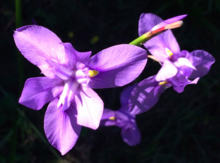
Moraea, the Cape tulips, is a genus of plants in the family Iridaceae, first described as a genus in 1758. The group is widespread across Africa, the Mediterranean, and central and southwestern Asia. The genus name is a tribute to the English botanist Robert More.

Astroloba rubriflora is a succulent plant found in the mountainous Karoo area around Robertson, South Africa. It is listed as a Vulnerable species on the IUCN global Red List.

Aloiampelos ciliaris, formerly Aloe ciliaris, the common climbing-aloe, is a thin, tough, rapidly growing succulent plant from South Africa.

Moraea aristata is a species of flowering plant in the family Iridaceae. It is referred to by the common names blue-eyed uintjie or Blouooguintjie in Afrikaans and is a critically endangered species of plant in the genus Moraea, that is endemic to the city of Cape Town and is now restricted to the grounds of the Observatory in the Cape Town suburb of Observatory.
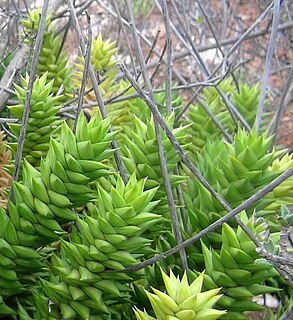
Astroloba spiralis is a small succulent plant of the Astroloba genus, endemic to the southern Karoo regions of the Western and Eastern Cape Provinces, South Africa.

Astroloba congesta is a small succulent plant of the Astroloba genus, indigenous to the Eastern Cape, South Africa.

Astroloba foliolosa is a small succulent plant of the genus Astroloba widespread in the arid parts of the Eastern Cape Province, South Africa.
Oncocalyx quinquenervius is a parasitic plant species in the family Loranthaceae native to South Africa. It is also known as banded matchflower.

Gymnosporia buxifolia is a species of plant in the family Celastraceae native to southern Africa. The common name is common spike-thorn.
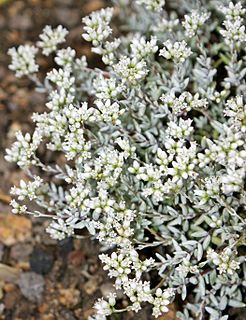
Crassula biplanata is a succulent plant native to rocky ledges and mountainous areas in the southern parts of South Africa.
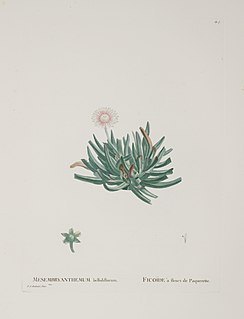
Acrodon is a genus of ice plants from South Africa. It comprises 8 species, mostly endangered and all restricted to the southern Cape regions of the Western Cape and Eastern Cape Provinces, South Africa.
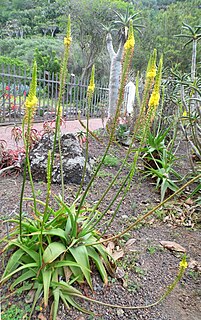
Bulbine alooides ("Rooistorm") is a species of geophytic plant in the genus Bulbine. It is widespread in rocky areas in the southern Cape of South Africa.
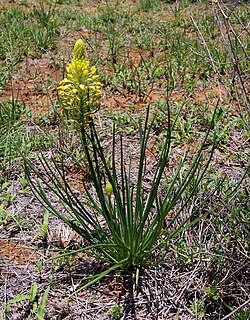
Bulbine abyssinica is a species of plant in the genus Bulbine, from eastern and southern Africa.
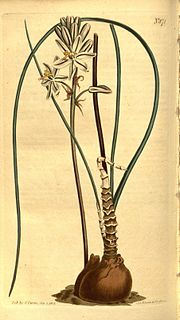
Drimia exuviata ("Gifbol") is a species of flowering plant in the family Asparagaceae, subfamily Scilloideae, indigenous to the south-western parts of South Africa.

Cyanella lutea is a species of cormous herb, native to South Africa, Lesotho and Namibia, where it grows in clay-rich or loamy soils.

Drosanthemum micans, is a succulent plant in the ice plant family, Aizoaceae, indigenous to the Robertson Karoo and Overberg regions of the Western Cape Province, South Africa.

Asparagus striatus ("Bergappel") is a hard perennial shrublet of the Asparagus genus, that is indigenous to dry, rocky areas of South Africa.

Asparagus mucronatus ("Katdoring") is a thorny shrub or creeper of the Asparagus genus, that is indigenous to the southern Cape regions of South Africa.
Asparagus multiflorus is a robust shrub or climber of the Asparagus genus, that is indigenous to the southern Cape regions of South Africa.

Protea aurea subsp. potbergensis, also known as the Potberg protea, or Potberg sugarbush, is a flowering plant of the genus Protea. It is endemic to South Africa and is found only in the Potberg near Cape Infanta. It grows to a height of 5 metres, and flowers primarily from May to June.
